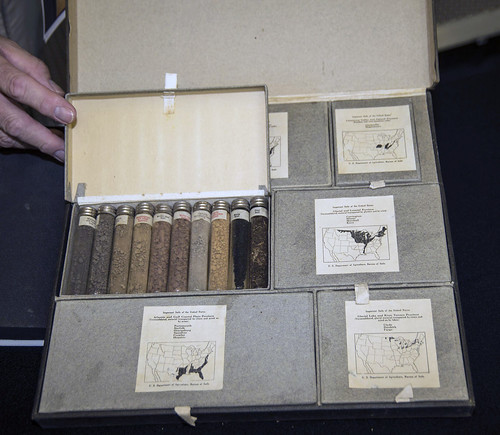
Thanks to the efforts of a dedicated science teacher from New Jersey, a valuable piece of soil science history is now available for viewing and research among the special collections at USDA’s National Agricultural Library (NAL) in Beltsville, Maryland.
Jill Guenther, who has taught Earth and space science for 29 years, discovered the antique soils collection tucked away in a classroom cabinet. “I knew it was something special, and I wanted to use it as a display when teaching erosion and conservation issues,” she explained.
Important Soils of the United States includes samples of soil and subsoil gathered nearly 100 years ago from various locations across the country and was distributed by the Bureau of Soils in 1916. The booklet that accompanied the samples explained that the purpose of the kit was to educate students about agriculture and physical geography.
Guenther realized she had something unique―and worth protecting. “I had a special interest in this since I come from a farming family and grew up on farms,” she said, “so I enjoyed a wonderful childhood and had the opportunity to appreciate the soil.”
In August, Guenther joined officials from the USDA’s Natural Resources Conservation Service (NRCS), Agricultural Research Service (ARS), and several soil professionals at the library for a brief ceremony where Guenther officially deeded the collection to NAL. “The donation of the soils kit and associated USDA publication allows NAL to preserve another important aspect of USDA’s history,” said Susan Fugate, Head of NAL’s Special Collections. NAL is a part of ARS, USDA’s in-house intermural research agency.
USDA-NRCS Assistant Chief Kirk Hanlin was at the ceremony to help recognize and thank Guenther for her efforts. “This collection is symbolic in that it represents turn-of-the-century efforts to educate and inspire students about the importance and life giving qualities of soil,” he said.
The donation of this antique collection this year―the International Year of Soils―is well-timed as NRCS and people around the world are celebrating this precious resource. “The soil survey is foundational to the work of NRCS, and as an agency, we have been working hard to create a national awareness of the importance of soil science and soil health,” said Hanlin.
The effort to catalogue the soils in 1916 ultimately led to the soil series concept of the soil survey and today’s modern Web Soil Survey. The survey provides soil data and information produced by the National Cooperative Soil Survey, managed and maintained by NRCS. The Web Soil Survey, maintained online as the single authoritative source of soil survey information, is the largest natural resource information system in the world.
The nearly 100-year-old soils collection was instrumental in helping educate students about the importance of soil resources. Today, NRCS is still working to motivate and inspire students, the general public, and farmers and private landowners, to think about the life giving qualities of soil. Guenther says the information these soils can give our scientists today is invaluable. “I am thrilled to know I had a hand in that,” she said.


